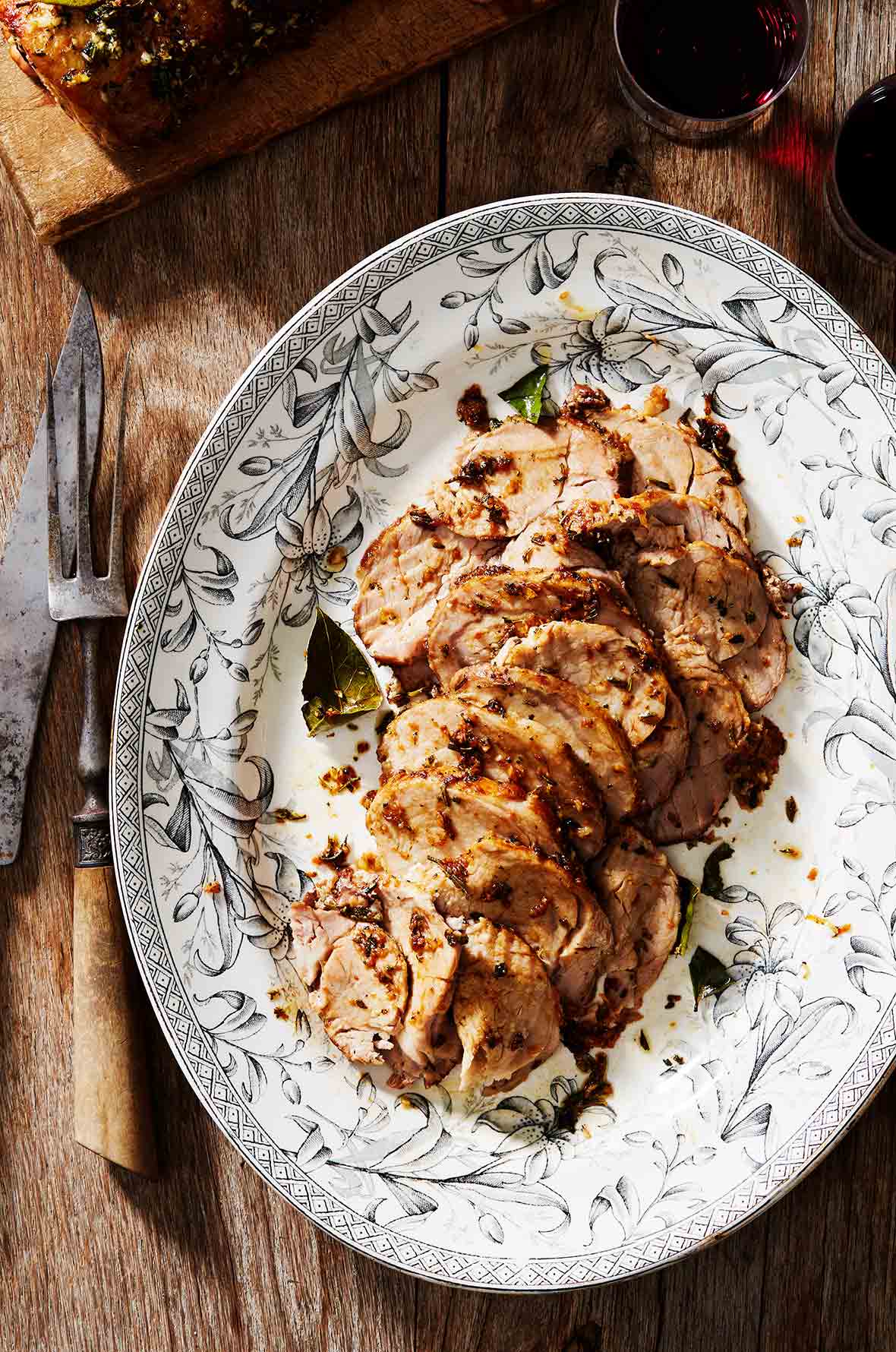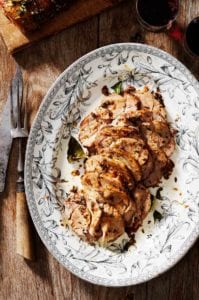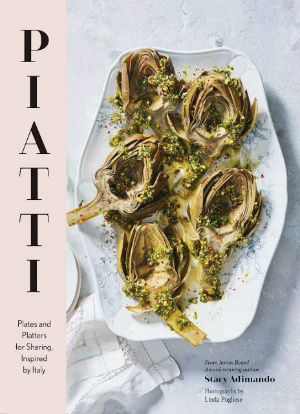
This slow roasted Tuscan pork loin, known in its lovely native language as Arista alla Fiorentina, is what you make when you want to impress with minimal effort. Simply sear it, rub it with an intoxicatingly aromatic herb paste, and slide it in the oven for a couple hours while you go about your day. Thinly sliced and heaped on a platter, it’s guaranteed to impress, although leftovers also make admirable sandwiches—so much so that it’s worth foregoing thirds to ensure there’s some left.–Angie Zoobkoff
What Exactly Is Arista alla Fiorentina?
Curious about what to expect from this Italian classic? In the words of the author, “Tuscan or Florentine-style roast pork—arista alla fiorentina—is often served just slightly warm, usually with white beans. Rosemary and garlic are common seasonings, but the anchovy gives the roast that special something—saltiness and savoriness, without any noticeably fishy flavors.”

Tuscan Roast Pork
Ingredients
- 4 large garlic cloves, peeled
- 2 tablespoons fresh rosemary leaves
- 2 tablespoons chopped fresh sage leaves
- 1 oil-packed anchovy fillet , or 1 teaspoon anchovy paste (optional)
- 5 tablespoons extra-virgin olive oil
- 2 pounds boneless center-cut pork loin (not tenderloin), thick fat cap left on
- 2 bay leaves, (optional)
- About 3/4 teaspoon kosher salt
Instructions
- Preheat the oven to 225°F (110°C) and position a rack in the center of the oven.
- Meanwhile, in the bowl of a small food processor, combine the garlic, rosemary, sage, anchovy (if using), and 3 tablespoons oil and process until a coarse paste forms. (Alternatively, you can use a mortar and pestle.)
- If desired, use kitchen string to tie the pork tightly crosswise about every 2 inches (5 cm). You can slip the bay leaves under the twine if you like. If you do not tie your pork, but wish to use bay leaves, simply carve a couple slits in the pork and tuck the bay leaves into the slits.
- Season the pork on all sides with the salt, rubbing the meat to coat it.
- In a large ovenproof skillet over medium-high heat, heat the remaining 2 tablespoons oil until shimmering. Add the pork and sear, starting with the fatty side and using tongs to turn it, until dark golden brown on all sides, 8 to 10 minutes total. Turn off the heat and let the pork in the skillet.
- Using an offset spatula or pastry brush, coat the pork with the herb mixture. If you’re the sort who likes the punch of raw garlic, reserve 1 tablespoon of the herb mixture to coat the pork after it comes out of the oven.
- Transfer the skillet to the center rack in the oven and roast until the meat is tender and the internal temperature is around 180°F (82°C), 2 to 3 hours. (Rest assured, if you just got alarmed at those numbers, that although this is a much higher internal temperature than we typically cook pork, it works.)
- Remove the skillet from the oven. If desired, brush the top and sides of the pork with the reserved 1 tablespoon herb mixture. Let the pork cool for at least 5 minutes.
- Transfer the pork to a cutting board, reserving the cooking juices in the skillet. Remove and discard the string and bay leaves, if using.
- Slice the pork very thinly (about 1/8 inch | 4 mm thickness) and arrange the slices on a serving platter. Drizzle with the juices and herbs from the pan. Serve warm or at room temperature.

Nutrition
Nutrition information is automatically calculated, so should only be used as an approximation.
Recipe Testers’ Reviews
In a word, OUTSTANDING! This roast pork came out wonderfully tender, juicy, and very flavorful. Could it be because it’s sliced so thinly or roasted low and slow or…who cares, whatever it is, it definitely works. The entire house smelled fabulous while it was roasting and we couldn’t wait to eat it!!
I used anchovy paste instead of anchovy filet since it was more convenient to use a little bit of the paste without having to open an entire tin of anchovies. This addition did add a subtle savory note of flavor to the roasted garlic and herbs in this dish.
I let it roast for 2 hours and checked the temperature and it registered 175°F. It looked beautiful so I took it out and let it rest while I prepared my side dishes. I opted not to use the remaining 1 tablespoon herb mixture after the roast came out of the oven, since I’m not a fan of raw garlic, and it was definitely not missed. The pan sauce drizzled over the slices were amazing!
In keeping with the flavors of Tuscany, I served the roast alongside warm white beans with rosemary and olives and steamed fresh broccoli.
I’ll definitely be serving this very impressive dish to guests!
A lovely roast pork loin that combines ease of roasting along with the fun reverse-searing that’s so satisfying.
In place of a skillet, I used a higher-sided Le Creuset that was large enough for the meat and caught the spatter as I seared. The fresh herb rub was good although a bit rosemary dominant. I think with such a small volume, if you do not have a smaller food processor (my is a full size Cuisinart), pre-chopping the rosemary by hand or in a spice grinder would help make a better paste, but it still turned out lovely as instructed.
While this recipe may be a weekend project, it was possible to pull it off on a weeknight. Deliciously comforting and the perfect thing to cook when your garden’s rosemary and sage have broken out madly after winter and are growing like crazy!
Since my pork tenderloin was quite a bit larger than specified, I divided it, using just over 2 pounds for this recipe and reserved the remainder for other projects (you could cut your extra portion into center-cut chops). The searing was easy, using tongs, and all sides including the ends were nicely browned (I started with the fattier side). I used a silicone brush to apply the herb mixture. At 2 hours and 15 minutes we were at 178℉, and I removed it to rest and then sliced just enough for the two of us.
On the second evening, I had the opportunity to remove the excess fat from the surface of the chilled pan drippings. I heated it with some extra chopped fresh sage and then strained it and added a splash of heavy cream. This slightly more refined sauce was delicious over the roast pork. The rest of the roast pork will be incorporated into sandwiches and tacos.
This roast pork loin was so juicy and delicious. Pretty simple ingredients with fresh herbs making all the difference. I did not use the anchovy fillet as the family is not a fan.
After nearly 2 hours, my pork loin had reached 184°F. I turned off the oven and finished up the sides. Pulled it out, sliced it thin and served with the juices from the pan.
Everyone raved. We will be making this again!
I don’t often cook roast pork loin and was intrigued by this recipe, especially the part about cooking it until it reaches 180°F. But the flavors sounded like a winner and so I gave it a shot. The recipe was super easy. It just took a long time.
And the recipe was right. Even though you cook the pork way beyond its technical done temperature, it didn’t dry out. In fact, when I pulled the pan out of the oven, there was a nice amount of pan juices that were delicious and great with the pork. Slicing it thinly, as the recipe calls for, is key.
I mashed everything up, sans anchovy, in my mortar and pestle and that worked fine. In lieu of anchovy, I sprinkled in a few drops of fish sauce.
Searing the meat is key, so be sure to get all sides nice and golden. Don’t rush it. It took fully 2 1/2 hours to roast and the meat was, indeed, juicy.
All in all, we really enjoyed this dish. Again, it was super easy but you have to be patient and let the magic of low and slow happen.
We got about 5 servings along with rosemary potatoes cooked on the grill and grilled asparagus.
“Wow” is the first word that comes to mind when you smell the combination of flavors in the herb paste for this Tuscan-inspired pork loin. A fragrant mixture of garlic, anchovy, fresh rosemary, fresh sage and fruity olive oil, this combination will transport you to an Italian frame of mind in no time!
Simple in its ingredients and preparation, this unique dish was enjoyed by all of us.
The only thing I would change would be that even after 2 hours and 30 minutes of cooking in the low oven, I think the meat could have been the slightest bit more tender. I’m wondering if, to achieve this, maybe adding some liquid to the pan in the last half of cooking would work well? Some dry white wine or even stock? The meat was tender, but I think we were looking for it to be just a touch more so.
I served the pork with some boiled baby red potatoes tossed with a homemade basil pesto, and some roasted broccoli with sweet peppers, shallots, and capers. A healthy, well-rounded Italian meal that we simply adored! I would love to try this paste on a roasted leg of lamb or even a roasted chicken sometime.
At first I thought that there wasn’t going to be a sufficient amount of herb paste given the size of my pork loin. Upon spreading it evenly, it came out to be just enough, delivering excellent flavor all around. I was shocked at how much impact the herb mixture made. It pleased my household, that’s for sure, and took me by surprise.













Made this roast for Christmas dinner–it was so easy and a big hit! Bought a four pound roast and cut it in two two-pound pieces to cook side by side in a cast iron dutch oven. Doubled the marinade. It needed about three hours to get to 175. I ran it under the broiler briefly to crisp the top a bit. Delicious, very tender and plenty for six diners with ample leftovers. Will definitely make this again.
Suzanne, we are delighted that everyone enjoyed this. It is a favorite in my house as well.
Delicious! Had a pork loin in the freezer and decided on this for Thanksgiving. My roast was a bit larger and not sure how long it took, used a probe thermometer, but perfectly juicy.
Thanks, Carlin. We’re so pleased that this turned out so well for you. We can’t wait to hear what you make next.